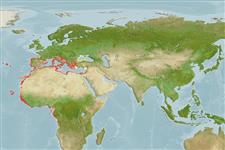Environment: milieu / climate zone / depth range / distribution range
Écologie
marin récifal; non migrateur; profondeur 2 - 40 m (Ref. 10797). Subtropical; 46°N - 12°S, 32°W - 36°E
Mediterranean Sea: Eastern Atlantic: Along the coast of Portugal to the Gulf of Guinea (St. Thomas Island = São Tomé Island), may also reach Angola. Quoted mainly in the islands (Azores, Salvage, Canary, Annobon, etc.) than on the continent.
Length at first maturity / Taille / Poids / Âge
Maturity: Lm ?, range 7 - 7.3 cm
Max length : 25.0 cm TL mâle / non sexé; (Ref. 10797); common length : 13.0 cm TL mâle / non sexé; (Ref. 10797)
Description synthétique
Clés d'identification | Morphologie | Morphométrie
Épines dorsales (Total) : 14; Rayons mous dorsaux (Total) : 9 - 11; Épines anales: 2; Rayons mous anaux: 9 - 11.
Adults form small shoals in midwater above or near rocky reefs or above seagrass meadows (Posidonia. They feed on small planktonic or benthic animals (Ref. 6760). Reproduce in summer (Ref. 6760). Eggs characterized by adhesive filaments are nested on rocky or sandy bottoms (Ref. 6760). Males guard the eggs (Ref. 6760).
Oviparous, distinct pairing during breeding (Ref. 205). Eggs are demersal and adhere to the substrate (Ref. 205). Breed on rocky or sandy bottoms (Ref. 6760). Males guard the eggs (Ref. 6760).
Loris, D. and J. Rucabado, 1990. Pomacentridae. p. 842-850. In J.C. Quéro, J.C. Hureau, C. Karrer, A. Post and L. Saldanha (eds.) Check-list of the fishes of the eastern tropical Atlantic (CLOFETA). JNICT, Lisbon; SEI, Paris; and UNESCO, Paris. Vol. 2. (Ref. 10797)
Statut dans la liste rouge de l'IUCN (Ref. 130435)
Menace pour l'homme
Harmless
Utilisations par l'homme
Pêcheries: intérêt commercial mineur; pêche sportive: oui
Outils
Articles particuliers
Télécharger en XML
Sources Internet
Estimates based on models
Preferred temperature (Ref.
123201): 16.2 - 27.8, mean 20.1 °C (based on 208 cells).
Phylogenetic diversity index (Ref.
82804): PD
50 = 0.5000 [Uniqueness, from 0.5 = low to 2.0 = high].
Bayesian length-weight: a=0.01259 (0.00992 - 0.01598), b=2.94 (2.87 - 3.01), in cm total length, based on LWR estimates for this species (Ref.
93245).
Niveau trophique (Ref.
69278): 3.8 ±0.4 se; based on diet studies.
Generation time: 4.8 ( na - na) years. Estimated as median ln(3)/K based on 2
growth studies.
Résilience (Ref.
120179): Milieu, temps minimum de doublement de population : 1,4 à 4,4 années (Preliminary K or Fecundity.).
Fishing Vulnerability (Ref.
59153): Moderate vulnerability (35 of 100).
Climate Vulnerability (Ref.
125649): Low to moderate vulnerability (27 of 100).
Nutrients (Ref.
124155): Calcium = 35.3 [16.4, 75.9] mg/100g; Iron = 0.564 [0.326, 0.937] mg/100g; Protein = 19.8 [18.8, 20.8] %; Omega3 = 0.227 [0.137, 0.370] g/100g; Selenium = 11.9 [5.9, 23.6] μg/100g; VitaminA = 79.5 [27.3, 240.2] μg/100g; Zinc = 0.895 [0.583, 1.322] mg/100g (wet weight);
